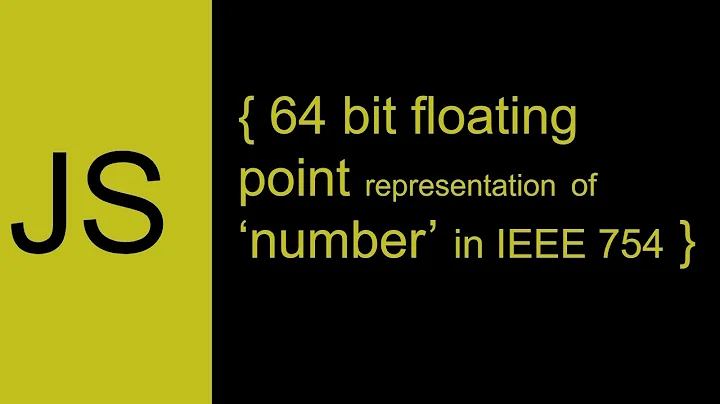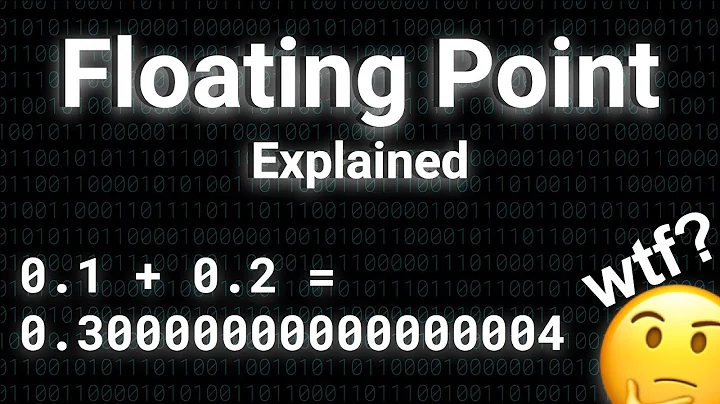How to convert a floating point number to its binary representation (IEEE 754) in Javascript?
Solution 1
new technologies are making this easy and probably also more forward-compatible. I love extending built in prototypes, not everyone does. So feel free to modify following code to classical procedural approach:
(function() {
function NumberToArrayBuffer() {
// Create 1 entry long Float64 array
return [new Float64Array([this]).buffer];
}
function NumberFromArrayBuffer(buffer) {
// Off course, the buffer must be at least 8 bytes long, otherwise this is a parse error
return new Float64Array(buffer, 0, 1)[0];
}
if(Number.prototype.toArrayBuffer) {
console.warn("Overriding existing Number.prototype.toArrayBuffer - this can mean framework conflict, new WEB API conflict or double inclusion.");
}
Number.prototype.toArrayBuffer = NumberToArrayBuffer;
Number.prototype.fromArrayBuffer = NumberFromArrayBuffer;
// Hide this methods from for-in loops
Object.defineProperty(Number.prototype, "toArrayBuffer", {enumerable: false});
Object.defineProperty(Number.prototype, "fromArrayBuffer", {enumerable: false});
})();
Test:
(function() {
function NumberToArrayBuffer() {
// Create 1 entry long Float64 array
return new Float64Array([this.valueOf()]).buffer;
}
function NumberFromArrayBuffer(buffer) {
// Off course, the buffer must be ar least 8 bytes long, otherwise this is a parse error
return new Float64Array(buffer, 0, 1)[0];
}
if(Number.prototype.toArrayBuffer) {
console.warn("Overriding existing Number.prototype.toArrayBuffer - this can mean framework conflict, new WEB API conflict or double inclusion.");
}
Number.prototype.toArrayBuffer = NumberToArrayBuffer;
Number.fromArrayBuffer = NumberFromArrayBuffer;
// Hide this methods from for-in loops
Object.defineProperty(Number.prototype, "toArrayBuffer", {enumerable: false});
Object.defineProperty(Number, "fromArrayBuffer", {enumerable: false});
})();
var test_numbers = [0.00000001, 666666666666, NaN, Infinity, -Infinity,0,-0];
console.log("Conversion symethry test: ");
test_numbers.forEach(
function(num) {
console.log(" ", Number.fromArrayBuffer((num).toArrayBuffer()));
}
);
console.log("Individual bytes of a Number: ",new Uint8Array((666).toArrayBuffer(),0,8));<script src="https://getfirebug.com/firebug-lite-debug.js"></script>Solution 2
Here's a function that works on everything I've tested it on, except it doesn't distinguish -0.0 and +0.0.
It's based on code from http://jsfromhell.com/classes/binary-parser, but it's specialized for 32-bit floats and returns an integer instead of a string. I also modified it to make it faster and (slightly) more readable.
// Based on code from Jonas Raoni Soares Silva
// http://jsfromhell.com/classes/binary-parser
function encodeFloat(number) {
var n = +number,
status = (n !== n) || n == -Infinity || n == +Infinity ? n : 0,
exp = 0,
len = 281, // 2 * 127 + 1 + 23 + 3,
bin = new Array(len),
signal = (n = status !== 0 ? 0 : n) < 0,
n = Math.abs(n),
intPart = Math.floor(n),
floatPart = n - intPart,
i, lastBit, rounded, j, exponent;
if (status !== 0) {
if (n !== n) {
return 0x7fc00000;
}
if (n === Infinity) {
return 0x7f800000;
}
if (n === -Infinity) {
return 0xff800000
}
}
i = len;
while (i) {
bin[--i] = 0;
}
i = 129;
while (intPart && i) {
bin[--i] = intPart % 2;
intPart = Math.floor(intPart / 2);
}
i = 128;
while (floatPart > 0 && i) {
(bin[++i] = ((floatPart *= 2) >= 1) - 0) && --floatPart;
}
i = -1;
while (++i < len && !bin[i]);
if (bin[(lastBit = 22 + (i = (exp = 128 - i) >= -126 && exp <= 127 ? i + 1 : 128 - (exp = -127))) + 1]) {
if (!(rounded = bin[lastBit])) {
j = lastBit + 2;
while (!rounded && j < len) {
rounded = bin[j++];
}
}
j = lastBit + 1;
while (rounded && --j >= 0) {
(bin[j] = !bin[j] - 0) && (rounded = 0);
}
}
i = i - 2 < 0 ? -1 : i - 3;
while(++i < len && !bin[i]);
(exp = 128 - i) >= -126 && exp <= 127 ? ++i : exp < -126 && (i = 255, exp = -127);
(intPart || status !== 0) && (exp = 128, i = 129, status == -Infinity ? signal = 1 : (status !== status) && (bin[i] = 1));
n = Math.abs(exp + 127);
exponent = 0;
j = 0;
while (j < 8) {
exponent += (n % 2) << j;
n >>= 1;
j++;
}
var mantissa = 0;
n = i + 23;
for (; i < n; i++) {
mantissa = (mantissa << 1) + bin[i];
}
return ((signal ? 0x80000000 : 0) + (exponent << 23) + mantissa) | 0;
}
Related videos on Youtube
GameZelda
Updated on April 25, 2022Comments
-
GameZelda about 2 years
What's the easiest way to convert a floating point number to its binary representation in Javascript? (e.g. 1.0 -> 0x3F800000).
I have tried to do it manually, and this works to some extent (with usual numbers), but it fails for very big or very small numbers (no range checking) and for special cases (NaN, infinity, etc.):
function floatToNumber(flt) { var sign = (flt < 0) ? 1 : 0; flt = Math.abs(flt); var exponent = Math.floor(Math.log(flt) / Math.LN2); var mantissa = flt / Math.pow(2, exponent); return (sign << 31) | ((exponent + 127) << 23) | ((mantissa * Math.pow(2, 23)) & 0x7FFFFF); }Am I reinventing the wheel?
EDIT: I've improved my version, now it handles special cases.
function assembleFloat(sign, exponent, mantissa) { return (sign << 31) | (exponent << 23) | (mantissa); } function floatToNumber(flt) { if (isNaN(flt)) // Special case: NaN return assembleFloat(0, 0xFF, 0x1337); // Mantissa is nonzero for NaN var sign = (flt < 0) ? 1 : 0; flt = Math.abs(flt); if (flt == 0.0) // Special case: +-0 return assembleFloat(sign, 0, 0); var exponent = Math.floor(Math.log(flt) / Math.LN2); if (exponent > 127 || exponent < -126) // Special case: +-Infinity (and huge numbers) return assembleFloat(sign, 0xFF, 0); // Mantissa is zero for +-Infinity var mantissa = flt / Math.pow(2, exponent); return assembleFloat(sign, exponent + 127, (mantissa * Math.pow(2, 23)) & 0x7FFFFF); }I'm still not sure if this works 100% correctly, but it seems to work good enough. (I'm still looking for existing implementations).
-
GameZelda almost 14 yearsMark Dickinson: I'm converting to 32-bit IEEE because the application will generate some values that will be used in a memory editor (that works with the address + bytes format). "exponent < -126" is right according to the Wikipedia. Exponents < -127 can't be represented, and exponent = -127 (that is 0 after adding bias) is used for zero and subnormal numbers (also according to the Wikipedia). And about -0.0, you're right. Is there any way to check if it's -0.0? Comparisons to 0.0 return true.
-
Janus Troelsen over 10 yearsYou can do it with typed arrays: stackoverflow.com/a/10564792/309483
-
-
qwertymk over 8 yearsIs there a simple way to go from a binary to a float or is it a matter or reversing this algorithm?
-
Kushal Kumar about 7 yearsis there any reverse algorithm for this?




